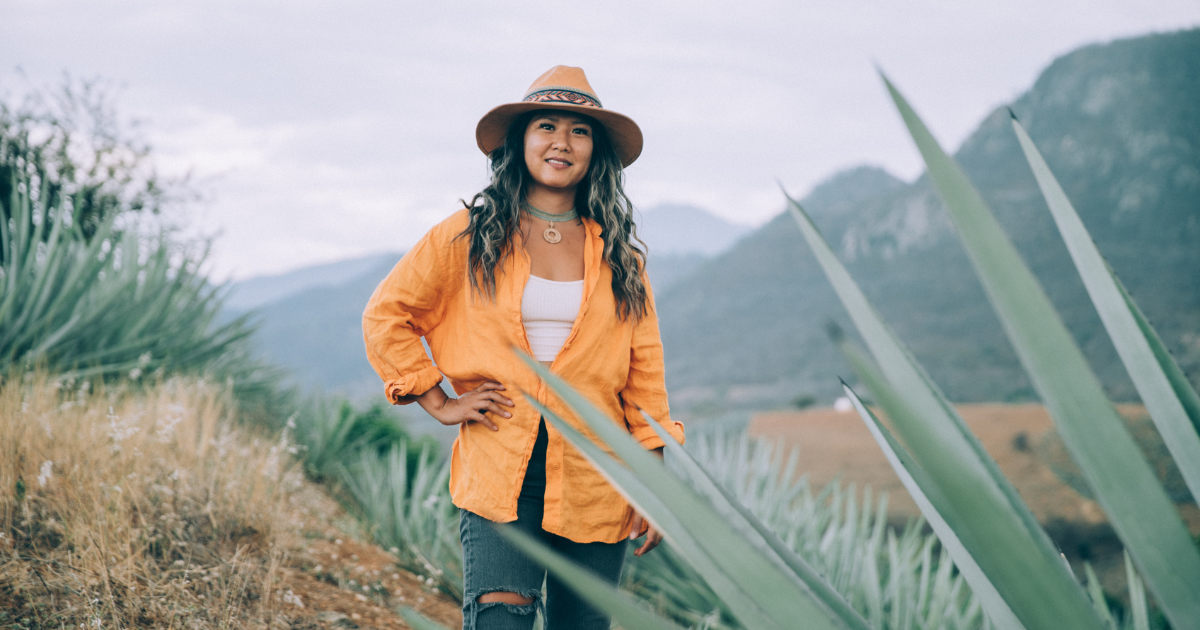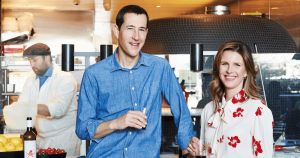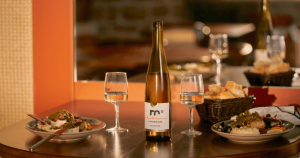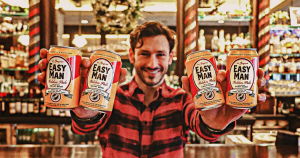Partner Content: Tomonotomo
Tomonotomo Founder Amanda Chen’s path took a transformative turn during the pandemic, when she permanently removed herself from behind the bar and found solace, inspiration, and a renewed sense of purpose in Mexico.
As Amanda dove deeper into the world of non-alcoholic spirits, she discovered that, although the market was exploding with new products, a lot of non-alcoholic spirits were simply made of water, “natural flavors,” and preservatives.
Inspired by her solo visit to Oaxaca City, Amanda decided to create a solution for herself—an all-natural, non-alcoholic distilled agave spirit, Tomonotomo. In this interview, she explains the inspiration behind her brand, her early production challenges, and her recent successes.
After 18 months of self-funding Tomonotomo, Amanda now invites you to be part of her journey via her Kickstarter campaign (ends March 31!). You can make your pledge today for as little as $5.
Dry Atlas: I’m curious about your journey into the non-alcoholic spirits world, especially considering your background as a bartender. What motivated you to embark on the challenging journey of creating a non-alc brand from scratch?
Amanda Chen: As a bartender before the pandemic, it was impossible to stop drinking. It wasn’t an encouraging environment and I didn’t feel supported. Mocktails weren’t taken seriously, and understandably, since they were really annoying to make for the price. They felt like a waste of time behind the bar.
But since the pandemic—and since having the opportunity to choose a sober lifestyle for myself—I realized that it’s not about creating a replacement or alternative to something. Rather, it’s about making a product that is easily a top choice whether you’re a drinker or not. That’s the inspiration behind Tomonotomo, which means “I drink, I don’t drink” in Spanish. I got really used to saying “no gracias, no tomo” every time I was offered a mezcal shot in Oaxaca. I didn’t want to start the brand with a negative, and that’s how the name was created.
Creating anything of value is going to be challenging—but it’s totally worth it. I wanted a sober lifestyle while living in Oaxaca. Why not make a non-alcoholic agave spirit, then? I’m in the perfect place, with all the resources to make a stand-out product that will set a standard for premium non-alcoholic distilled spirits. No more hiding behind sodas with lime to fit in with everyone. Just enjoying high-quality, great-tasting cocktails and creating meaningful experiences you’ll actually remember the next morning.
DA: Do you think it’s better that you entered this venture without beverage formulation experience? Maybe bringing a fresh perspective as a first-time beverage entrepreneur offers some kind of advantage.
AC: Although this is my first time making a beverage, I’m no stranger to the beverage industry, which made me feel confident about embarking on this journey. With the success of my first business, Salty Paloma, I thought if I could create and market flavored salt rimmers for margaritas, I could definitely create a spectacular non-alcoholic agave spirit.
I followed the same formula I used with my first business: find out what everyone else is doing and do it better. It was appalling to uncover that pretty much all the non-alcoholic “tequila” and “mezcal” alternatives didn’t even include agave—just agave extract, agave syrup, or other “natural” flavorings to create an incorrect flavor of what tequila and mezcal would be.
With my extensive experience working with tequila and mezcal brands through Salty Paloma, I realized that a lot of us might not really know what a good agave spirit actually tastes like. We probably mostly remember our drunken college days shooting shots of really bad tequila with salt and lime.
A truly well-done distilled spirit goes down smoothly. I discovered a lot of the non-alcoholic spirit alternatives tried to mimic a “burn” or “bite” with chili or cinnamon that created more of a throat choke than anything else. With that information, I threw out trying to be like the rest and focused only on making a delicious distilled spirit without the alcohol.
I also wasn’t alone in this. As the brains behind the business and the brand, I needed to find myself a partner who could turn the product I had in my mind into a reality. It was a quick dead-end trying to tell mezcaleros to make mezcal without the alcohol. Then I worked with universities in food labs and other private food companies before finding my “mad scientist” in a Oaxaca City park one summer day in 2022. Although we have completely different personalities, we both have the same goals: to live our life our own way, to work when and how we want, and to enjoy delicious beverages that come from real ingredients—sourced sustainably and distilled with craft and care.
Regardless of my experience, I knew I wanted to create a totally different product that didn’t exist yet. That’s really the fun part for me. How do I make a non-alcoholic spirit that isn’t de-alcoholized or evaporated? After nearly two years of R&D, I found a natural way to ferment and distill agave so that it’s non-alcoholic from the start. No wasted alcohol, no chemical processes, no preservatives. I was actually really surprised that with a little extra effort I could create a truly delicious, all natural, non-alcoholic spirit distilled through traditional copper stills, keeping a respect for the craft of spirits.
DA: Your dedication to craft definitely shines through. What challenges did you face and overcome?
AC: I think the biggest challenge is still explaining why to choose an NA spirit to begin with. Those are not the people I’m speaking to. People who want alcohol will want alcohol. We’re not here to convince anyone to change their mind about alcohol.
Since a lot of alcoholic spirits are known to be consumed on their own, especially tequila and mezcal, there’s a similar expectation with non-alcoholic agave spirits. And while you can consume Tomonotomo neat, it’s really created to offer bartenders a more complex spirit to play with—to create high quality non-alcoholic cocktails that hold their weight.
Whether you consume it neat, on ice, in a cocktail, or mixed with alcohol, it’s filled with so many delightful aromas and botanicals to really get those creative juices flowing. If you’re a professional bartender or just a cocktail enthusiast that enjoys shaking drinks at home, this is a high quality spirit made with all-natural ingredients to set you up for success and allow you to enjoy cocktails in whichever way you want.
We’re here to simply bring a beautiful, agave-based spirit to people who don’t want to drink or don’t want to get drunk. Whatever their reason for not drinking, it’s an option for them. I’ve taken a softer approach. Instead of saying, “you have to drink this, it’s better for you.” It’s more like, “this is here for you. You have the freedom to choose if you want to.” Tomonotomo has already been served at events with an alcoholic and non-alcoholic version of the same cocktail recipe. Tomonotomo often sells out first, showing that when you give people the option, they’re like, “cool. I’ll go for the non-alcoholic.” Just give them the option and people end up choosing a healthier option on their own.
DA: It’s encouraging to see that induced demand. Once you landed your mad scientist partner and decided on the parameters for creating Tomonotomo, was it just trial and error? Or was it a lot of planning and then hitting go?
AC: There was a lot of trial and error. Initially, I brought in the competition’s products for comparison. I really just wanted to be better than the competition. I remember asking my scientist to make something taste like nail polish, and he was like, “sure, we can do nail polish with bananas.” We started to do that. It just tasted like bad tequila.
My scientist pushed back, saying, “Amanda, do you want to end up with bad tequila? What’s the point of all this effort if it’s just going to taste bad? You know what good tequila tastes like. Shouldn’t we focus on making a good product?” That made me realize I don’t need to merely conform to existing competition. I’m not going to offer some weird, pepper-burning alcohol water. I want to offer something made with real ingredients, passion, and care. We chose Tobalá, a rare agave found in the mountains here in Oaxaca, which gives a nice, sweet floral note.
Without realizing it, I created a premium spirit. There hasn’t been much of a market for premium spirits like whiskeys and tequilas. Tomonotomo is a premium spirit. In the future, Tomonotomo might even focus on super-premium agave distillates that are non-alcoholic. Rare agaves take 25 to 30 years to grow—offering them in formats that allow people to experience them without the alcohol. This opens up the world a lot.
DA: I love that you’re talking about the more premium side of things. I’ve long been confused about the connection between “premium” and ethanol, and the fact that alcoholic cocktails are often priced higher on bar menus than equally complex non-alcoholic ones. Can you explain what makes a non-alcoholic spirit premium to you, especially for consumers for whom that seems contradictory?
AC: I always like to consider the plant-based industry as a comparison. What’s the difference between a gourmet veggie burger and a dressed-up frozen one in a restaurant? Knowing it came from scratch and they put everything together themselves is the same idea for a premium non-alc spirit.
Even without alcohol, they’ve added premium elements. If you’re paying $25 for a non-alcoholic cocktail, they’re likely fermenting fruits and vegetables, creating syrups, and doing all this work for a specific flavor based on the theme of their restaurant. It isn’t like, “I’ll just open some soda water and a drop of lime, call that a cocktail.” It commands respect.
Right now, many bartenders are like, “a mocktail request… what do I do?” Now, with the right tools, they can make something they can stand behind. It offers a sense of confidence to the bar and restaurant industry, as well as to the consumer.
DA: That makes sense. When you think about your product and bringing it to life, is your goal more than getting it on the bar and educating bartenders? Or are you envisioning that an at-home mixologist can whip up something complex and premium without the expertise of a bartender?
AC: I think it’s a little bit of both. I want Tomonotomo to be accessible to the amateur mixologist and give them a good product to start with. If you give them a lesser product, it’s harder for them to work with it. They just have to settle for whatever flavor there is.
Whereas, with a high-quality product, it’s easier for them to create cocktails. It’s easier for bartenders to create cocktails, too, and it’s more exciting for them in particular.
What’s great about Tomonotomo is it can be mixed with alcoholic spirits. Bartenders sometimes do 50/50, like a shot of alcoholic mezcal and a shot of Tomonotomo. Then Tomonotomo brings out the complexities in both spirits because of the 14 ingredients, which pop depending on the spirits and mixes you put together.
You can sip by itself or have it with soda and lime. However you want to make it, at whatever level, it’s for people who want a good, high-quality drink. There’s no need to settle for something else.
DA: It seems you’re more focused on indulgence and experience than helping you cut back on “the real deal.”
AC: Yes. Instead of thinking, “oh man, I have to cut back on calories, I have to cut back on alcohol”—that’s a negative that you’re trying to fix. I’m more about, “I want to drink this simply because it tastes good.” The question of whether it’s alcoholic vs. non-alcoholic is thrown out the window. It doesn’t matter anymore, because it’s something that tastes good.
It’s the same thing with plant-based products. If it tastes good, it doesn’t matter if it’s cauliflower, chickpea, or whatever. It just tastes good, so I’m going to buy it again.
DA: Looking ahead, you hinted about getting more into the super-premium, potentially aged, tequila and mezcal space. Are you looking to perfect your current formulation as your next step? Or are you looking to quickly expand your range?
AC: We’re definitely going to stay the agave experts in this space and start introducing premium spirits, bringing in the culture of and respect for ancestral distillation, plus the craft of making agave spirits.
As we all move toward spirit alternatives, we risk losing the whole history and culture behind why these spirits were even created to begin with. Sourcing solely from Oaxaca and crafting here brings consumers closer to the spirit itself. There’s less distance between the alcohol we’re used to and this product. Blurring the space to focus on a great agave product is our aim; that’s how we’ll do it differently.
We’ll likely have many limited-edition products based on agave sustainability, offering us opportunities to work with local farmers. There’s a growing presence of women-owned agave businesses in Oaxaca, too, with a new generation taking over their parents’ distilleries and innovating production methods. It’s important for me to participate in and collaborate with these initiatives.
DA: What’s the one thing you want to leave our Dry Atlas readers with?
AC: I want to bring awareness to ingredients on labels. It’s been challenging to talk about the advantages of Tomonotomo, because every other brand can say they’re all-natural. Every other brand says they’re made with agave, but they’re made with agave extracts or natural flavorings.
Look at the difference between the four or five ingredients of citric acid and preservatives versus my 14 real ingredients on the label. If you’re health-conscious and already not drinking, consider taking the extra step to select something quality on top of just being non-alcoholic.
To learn more about Amanda and Tomonotomo, check out their website. To become part of Amanda’s Kickstarter campaign, make your pledge.






